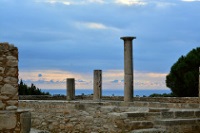
Kition was an ancient city-state on the southern coast of Cyprus in today's Larnaca. Some of the ruins can still be seen, featuring the remains of five temples dating back to the 13th century BC. Of particular interest is the Phoenician Temple of Astarte, which was built on the ruins of an earlier Bronze Age temple. The lower part of the northern city walls are also still visible, built of huge stones resembling Mycenaean cyclops. Residents in Larnaca are still finding artefacts all over the city, and a number of building projects have been abandoned due to fresh discoveries.
Opening times : Monday to Friday 9am-2:30pm; Thursdays 3pm-5pm (except July and August).
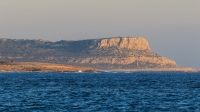
The natural beauty of Cape Greco makes it one of the first locations in tourists' itineraries. The unique headland stretches out into the gorgeous blue ocean, with fascinating shapes peeling off from the cliffs into the shore waters. There are also trails which will appeal to hikers, exploring the surrounding national park filled with a wide variety of flora and fauna. For those more inclined to adventure, there are also opportunities for cliff jumping, diving, and swimming in sea caves.
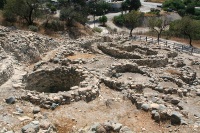
About 20 miles (32km) from Larnaca on the Lefkosia-Lemesos Road, archaeological excavations at Choirokoitia have revealed one of the oldest Neolithic sites on Cyprus, dating back to around 7000 BC. Also known as Khirokitia, it was home to primitive farmers who cultivated wheat and barley. Visitors can explore the settlement's defensive wall, circular houses, and tombs. The site was first excavated in 1934 and work continues to this day. Four of the beehive-shaped houses made of mud and stone have been reconstructed to show how these early farmers lived. Most of the finds from Choirokoitia are displayed in the Cyprus Museum in Nicosia.
Address : 32km from Larnaka, off the Larnaka – Lemesos highway
Website : www.larnakaregion.com/directory/product/choirokoitia-neolithic-settlement

The 9th-century Church of Saint Lazarus stands in Larnaca as an important religious institution on Cyprus. Lazarus is believed to have lived at ancient Kition for 30 years after his resurrection by Jesus Christ, and was ordained the Bishop of Kition by Saints Barnabas and Mark. The church was built by the Byzantine Emperor Leo VI above what was believed to be the empty grave of Saint Lazarus. Subsequently, there are those who believe his final resting place to be in Marseilles, France. Eight days before the annual Greek Orthodox Easter, the Baroque wood-carved icon of the saint is carried in a procession through the streets of the town.
Address : Plateia Agiou Lazarou
Website : larnakaregion.com/directory/product/agios-lazaros-saint-lazarus
Telephone : 24 652 498
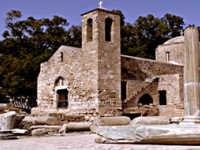
This fascinating and well-stocked museum is housed in the upper level of the Larnaca Castle on the city's seafront. The castle itself is the main attraction, built in 1625 by the Turks to defend the city from invasion. There is still a Turkish inscription above the doorway. Later it was used as a prison during the early years of British rule. One of the most popular attractions in Larnaca, the castle also operates as the Larnaca Municipal Cultural Centre during the summer and hosts local cultural events. The museum contains displays from the early Christian, Byzantine, Lusignan, and Ottoman periods.
Address : Larnaca Castle
Website : www.visitcyprus.com/index.php/en/discovercyprus/rural/sites-monuments/item/2402-sites-monuments
Opening times : Monday to Sunday. 8am to 5pm, September 16 to April 15. April 16 to September 15, 8am to 7.30pm. Closed on public holidays.
Admission : €2.50
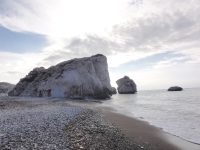
Perhaps one of the most famous attractions on the island of Cyprus, the Rock of Aphrodite is an ocean outcrop surrounded by myth and legend. Said to be the birthplace of the Greek goddess of love, it was also supposedly put there by the Byzantine hero Basil to keep out invading Saracens. Seeming to bubble with divine energy, the waves are quite forceful and so tourists are encouraged to neither swim nor climb the rock formations. The area is also known as Petra tou Romiou, meaning 'Rock of the Roman'.

Perched atop a solitary mountain is the oldest monastery in Cyprus, Stavrovouni Monastery was founded in the 4th century by Saint Helena. Its most treasured relic is a supposed fragment of the holy cross, encased in a silver cross which is not visible to the public. Another artefact left by Helena at the monastery is the Cross of the Good Thief, which includes the nail and part of the rope said to have tied Jesus to the cross. The monastery is perched upon the eponymous mountain that used to be called Olympus. Reached by a winding steep road, the monastery is considered the spiritual centre of Cyprus and now houses an order of monks.
Address : 40km from Larnaka, 9km off the Lefkosia-Lemesos road
Website : larnakaregion.com/directory/product/stavrovouni-monastery-
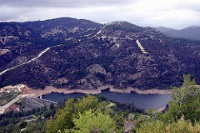
Within the interior of Cyprus and north of Limassol, the Troodos Mountains offer beautiful scenery, ski trails, and walks for nature lovers. The Troodos Mountains are the largest mountain range in Cyprus, so it is no wonder that they are also a popular winter destination. They are one of only a handful of places in the world where visitors can ski in the morning, and swim and sun tan in the afternoon. The main ski slopes are on the 6,401 foot (1,951m) Mount Olympus, roughly an hour's drive from Nicosia or Limassol, and the ski season extends from the beginning of January to the end of March.
Address : Located roughly in the center of the island
Website : www.mytroodos.com/en/

01474 814411

Travel Guide powered by Word Travels, copyright © 2023 Globe Media Ltd. By its very nature information in this travel guide is subject to change at short notice and travellers are urged to verify information on which they're relying with the relevant authorities. Neither Globe Media Ltd nor Travel Vogue can accept any responsibility for any loss or inconvenience to any person as a result of information contained above.